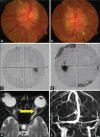Idiopathic Intracranial Hypertension: The Monster Within
- PMID: 32189855
- PMCID: PMC7061511
- DOI: 10.4103/aian.AIAN_190_19
Idiopathic Intracranial Hypertension: The Monster Within
Abstract
Idiopathic intracranial hypertension (IIH) is defined as a syndrome of raised intracranial pressure with normal imaging of the brain and cerebrospinal fluid (CSF) composition. There are many controversies and myths that surround IIH. Although patients of IIH may present "typical" symptoms and signs of raised intracranial pressure, clinical scenarios often vary. A typical clinical and radiological finding poses significant problems in diagnosis and management of patients with IIH. We have tried to resolve these controversies and provide a comprehensive update on different aspects of IIH. In this article, we review the common problems encountered while dealing with patients of IIH.
Keywords: Benign intracranial hypertension; headache; idiopathic intracranial hypertension; pseudotumor cerebri syndrome; visual loss.
Copyright: © 2020 Annals of Indian Academy of Neurology.
Conflict of interest statement
There are no conflicts of interest.
Figures



References
-
- Foley J. Benign forms of intracranial hypertension; toxic and otitic hydrocephalus. Brain J Neurol. 1955;78:1–41. - PubMed
-
- Corbett JJ, Savino PJ, Thompson HS, Kansu T, Schatz NJ, Orr LS, et al. Visual loss in pseudotumor cerebri. Follow-up of 57 patients from five to 41 years and a profile of 14 patients with permanent severe visual loss. Arch Neurol. 1982;39:461–74. - PubMed
-
- Smith JL. Whence pseudotumor cerebri? J Clin Neuroophthalmol. 1985;5:55–6. - PubMed
-
- Friedman DI, Liu GT, Digre KB. Revised diagnostic criteria for the pseudotumor cerebri syndrome in adults and children. Neurology. 2013;81:1159–65. - PubMed

